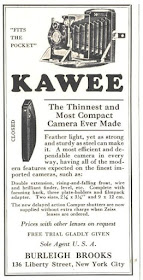* * *
 |
| Cottonwoods |
 |
| Downtown |
 |
| Conservatory |
* * *
Plate cameras were very popular in the 1920s and '30s. All the major manufacturers made them and all had essentially the same set of features, often using the same Compur shutters and Zeiss lenses. The folding plate cameras were very compact compared to other popular styles available in those days and the KW Patent Etui (KAWEE) and the Bentzin Primar were notable for their extremely clever design which allowed them to be folded up and easily slipped into a pocket. When folded, the Patent Etui occupied about the same space as a packet of three plate holders, or a filmpack adapter.Accessory roll film holders were available for all the plate cameras; the two most common being the Rada and the Rollex. Because of the thin slots on the back of the Patent Etui, only the Rollex will work with my 6.5x9 KW cameras. While the roll film back did provide a relatively easy way to use commonly available roll film cartridges with the plate cameras, it did also negate the plate camera's compactness to a large degree.
It is possible even today to purchase glass plates for use with the plate film cameras, but the multi-sheet film packs have not been available for decades and cut film is hard to find in the 6.5x9 size. I have so far only used my plate cameras with the roll film adapters.
All of the plate cameras come with three options for viewing the subject to be photographed. The ground glass backs are essential when high precision is required for framing the subject as in close-up work. The need to switch out the film back with the ground glass back makes for a rather awkward and time-consuming process and a sturdy, stable tripod is essential. The little reflex finder and the wire frame finders make hand-held operation possible and are quicker to use, but still require some careful alignment to yield a good result.
I sometimes use the reflex finder and it works, but the image is pretty small and easily obscured if the head is not held precisely in the right position relative to the finder. The bubble level next to the finder is helpful in keeping the image properly angled.
On the Patent Etui a little post is flipped up to use in conjunction with the swing-out wire frame finder. With the round tip of the post properly centered, the wire frame will enclose the portion of the scene which will be recorded on the film. It takes some practice to get good framing with such an arrangement.
So, while good results from any of the plate cameras do require some time and practice to achieve, their features can provide a great deal of versatility and deliver images of excellent quality. Even with relatively simple 3-element uncoated lenses like the Trioplan the big 6.5x9 or 9x12 negatives will provide sharp pictures with a deep range of tonal values. If you need further convincing of the picture-making capacities of the little plate cameras, just take a look at the work Brassai did with his.





No comments:
Post a Comment
Comments on posts older than 7 days will not be published until reviewed.